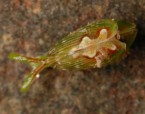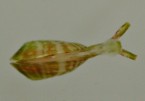| Home |
| Acknowledgments |
| Conventions |
| Glossary |
| Maps |
| References |
| Links |
| Articles |
| Thumbnails |
| Species
list |
| Family |
| Next
species |
Additional Photos

top

underside

young, 1.5 mm

shell
_______________
GALLERY

Julia zebra Kawaguti, 1981

| Maximum size: 4.7 mm
(extrapolated from shell length). Identification: This species has a brownish-green shell with narrow, radiating, dark brown stripes and cloudy white patches. The hinge tooth is proportionately smaller and more circular than in Julia exquisita and Julia sp. #2. The animal is brownish-green flecked with white and with dark brown bands on top of its head. The "butterfly-shaped" cream patch outlined in brown that surrounds the hinge is the result of pigment showing through the partially translucent shell. (Note 1) Natural history: Julia zebra is a common species found in protected to exposed rocky habitats at depths of < 1 to 15 m (< 3 to 49 ft). Although diurnal, it's seldom seen due to its small size and cryptic coloration. Alison Kay found it in association with the green algae Microdictyon in 1962. (Kay, 1962c) Distribution: Big Island, Maui, Oahu, Kauai, French Frigate Shoals and Midway: widely distributed in the Indo-Pacific and possibly the eastern Pacific. Taxonomic notes: Shells collected from beach drift in the eastern Pacific and held at the California Academy of Sciences under the name Julia thecaphora (Carpenter, 1857) appear identical to those of the Indo-Pacific Julia Zebra. Presumably, that name would have priority if confirmed with live material. Live animals photographed at Easter Island also appear identical to Hawaiian material. In southern Japan, many animals lack all or most brown pigment. However, the "butterfly-shaped" marking on the hinge in live animals and the smaller hinge size in shells still appear to distinguish those animals from J. exquisita. Live animals were probably first recorded in Hawaii from Koloa, Kauai by Alison Kay in April, 1962. (Kay, 1962c) Photo: CP: 3.6 mm: Hekili Point, Maui; March 22, 2006. Observations and comments: Note 1: Shells of this species show moderately strong red fluorescence under ultraviolet light (395 nM), most prominently when worn. |
| Thumbnails |
Species
list |
Family | Next species | Top |